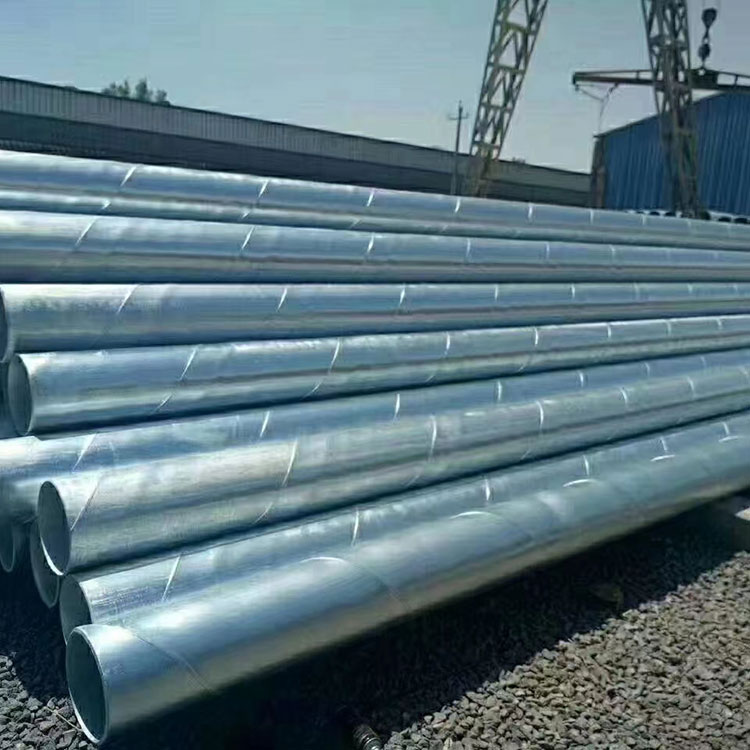

Galvanized Steel Pipe is a widely used pipe material. It is based on steel pipes, and a layer of zinc is covered on the surface of the steel pipes through processes such as hot-dip galvanizing or electro-galvanizing. This zinc layer not only gives galvanized steel pipes unique properties, but also makes them play an important role in many fields.

Good corrosion resistance is one of the most prominent features of Galvanized Steel Pipe. Zinc is a relatively active metal that can quickly react with oxygen in the air to form a dense zinc oxide film. This film can prevent the steel pipe matrix from further chemically reacting with oxygen, moisture, etc. in the air, thereby greatly extending the service life of the steel pipe. Whether in a humid environment, such as a building water supply and drainage system, a sewage treatment plant, or in a corrosive industrial site, galvanized steel pipes can work stably and reliably with their corrosion resistance. For example, in construction projects in coastal areas, the air contains more salt, which is highly corrosive to metal materials. Galvanized steel pipes can effectively resist the erosion of salt spray and ensure the normal use of building facilities.
Strong mechanical properties: Galvanized steel pipes inherit the high strength and good toughness of steel pipes themselves. As a basic material, steel pipes have high compressive strength and bending resistance, and can withstand greater pressure and weight. After galvanizing, its mechanical properties are not significantly affected, but enhanced to a certain extent. In building structures, galvanized steel pipes are often used as supporting structural parts, such as scaffolding, steel structure frames, etc., which can firmly support the weight of the building and ensure the safety of the building. At the same time, in some occasions that need to withstand impact, such as bridge anti-collision guardrails, galvanized steel pipes can also absorb energy and reduce the degree of damage when hit by impact with their good toughness.
The surface of Galvanized Steel Pipe presents a silver-gray luster and has good decorative properties. This beautiful appearance makes it not only suitable for engineering fields with performance requirements, but also for some places with certain requirements for appearance. For example, in the interior decoration of some commercial buildings, galvanized steel pipes can be used as decorative pipes to construct unique spatial shapes, which not only meet structural requirements, but also add a sense of modernity and industrial style to the space. Moreover, the surface of the zinc layer is relatively smooth, not easy to be stained with dirt, easy to clean and maintain, and can maintain a good appearance for a long time.
Galvanized steel pipes have good processing performance and can be made into shapes and sizes that meet the needs of different projects through various processing methods such as cutting, welding, and bending. Its cutting process is relatively simple and can be operated using ordinary cutting tools; the welding performance is also good, and it can match a variety of welding materials and processes to ensure welding quality. In terms of installation, galvanized steel pipes are relatively light and easy to carry and install. At the same time, it has a variety of connection methods with other pipe fittings, such as threaded connection, flange connection, groove connection, etc., which can adapt to different installation environments and engineering requirements, greatly improving construction efficiency. For example, in some small water supply and drainage projects, the threaded connection method is adopted, and construction personnel can quickly complete the installation of galvanized steel pipes and shorten the project cycle.
During the handling, storage and installation of Galvanized Steel Pipe, care should be taken to avoid scratching the zinc layer on its surface. Once the zinc layer is damaged, the steel pipe matrix will be exposed to the air and prone to corrosion. When transporting, appropriate tools such as slings, forklifts, etc. should be used to avoid direct contact between the steel pipe and sharp objects. If it is necessary to mark or other operations on the surface of the steel pipe, methods that will not damage the zinc layer should be used, such as using a special marking pen. During storage, galvanized steel pipes should be placed in a flat and dry place to avoid mutual squeezing and collision. If conditions permit, soft materials such as rubber pads and wooden boards can be placed between the steel pipes to play a buffering and protective role.
Galvanized steel pipes are widely used in various fields for their many advantages. During use, as long as their characteristics are fully understood and the precautions for use are strictly followed, their performance advantages can be fully utilized to ensure the quality and safety of the project, while reducing maintenance costs and improving economic benefits. Whether in construction engineering, municipal engineering or industrial fields, galvanized steel pipes will continue to play an important role and provide reliable guarantees for the construction and operation of various infrastructure.